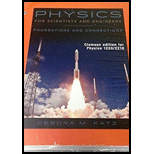
Concept explainers
(a)
The difference between two waves on a string given by
(a)
Answer to Problem 1PQ
The wave 1 propagates in
Explanation of Solution
Write the expression for a wave travelling along
Here,
Write the expression for a wave travelling along
Here,
Write the given waves in string.
Conclusion:
Consider the mathematical expression
Rearrange equation (III) using above equation and change wave in equation (III) into sign wave.
The above equation represents same cosine wave in terms of sinusoidal wave with initial phase of
Now comparing above equation with equation (I) it is clear that equation (V) and (I) are matching. Thus, the wave is travelling along
Consider the mathematic expression
Rearrange equation (IV) using above equation and change the wave in equation (IV) into sign wave.
The above equation represents same cosine wave in terms of sinusoidal wave with initial phase of
Now comparing above equation with equation (II) it is clear that the equations (VI) and (II) are matching. Thus, the wave is travelling along
Therefore, the wave 1 propagates in
(b)
The wave that results on this string.
(b)
Answer to Problem 1PQ
The wave that results on this string is
Explanation of Solution
Rewrite equations (III) and (IV).
When these waves moves in medium with one along
Write the expression for the resultant of these waves.
Conclusion:
Substitute (III) and (IV) in (VII) to get resultant of two waves.
Use trigonometric equation,
Therefore, the wave that results on this string is
(c)
The amplitude of resultant wave.
(c)
Answer to Problem 1PQ
The amplitude of resultant wave is
Explanation of Solution
The resultant standing wave is
Write the standard equation of a standing wave produced from waves given in (I) and (II).
In above equation the term in square bracket
Conclusion:
Comparing above two equations, it is clear that
Therefore, the amplitude of resultant wave is
Want to see more full solutions like this?
Chapter 18 Solutions
Physics for Scientists and Engineers: Foundations and Connections
- A transverse sinusoidal wave on a string has a period T = 25.0 ms and travels in the negative x direction with a speed of 30.0 m/s. At t = 0, an element of the string at x = 0 has a transverse position of 2.00 cm and is traveling downward with a speed of 2.00 m/s. (a) What is the amplitude of the wave? (b) What is the initial phase angle? (c) What is the maximum transverse speed of an element of the string? (d) Write the wave function for the wave.arrow_forwardThe equation of a harmonic wave propagating along a stretched string is represented by y(x, t) = 4.0 sin (1.5x 45t), where x and y are in meters and the time t is in seconds. a. In what direction is the wave propagating? be. N What are the b. amplitude, c. wavelength, d. frequency, and e. propagation speed of the wave?arrow_forwardTwo traveling sinusoidal waves are described by the wave functions y1 = 5.00 sin [(4.00x 1 200t)] y2 = 5.00 sin [(4.00x 1 200t 0.250)] where x, y1 and y2 are in meters and t is in seconds. (a) What is the amplitude of the resultant wave function y1 + y2? (b) What is the frequency of the resultant wave function?arrow_forward
- A standing transverse wave on a string of length 60 cm is represented by the equation y(x, t) = 4.0 sin(x/15) cos(96t), where x and y are in centimeters and t is in seconds. a. What is the maximum value of the standing wave at the point x = 5.0 cm? b. Where are the nodes located along the string for this particular standing wave? c. What is the vertical velocity vy of the string at x = 7.5 cm when t = 0.25 s?arrow_forwardA standing wave on a string is described by the equation y(x, t) = 1.25 sin(0.0350x) cos(1450t), where x is in centimeters, t is in seconds, and the resulting amplitude is in millimeters. a. What is the length of the string if this standing wave represents the first harmonic vibration of the string? b. What is the speed of the wave on this string?arrow_forward
 Physics for Scientists and Engineers: Foundations...PhysicsISBN:9781133939146Author:Katz, Debora M.Publisher:Cengage Learning
Physics for Scientists and Engineers: Foundations...PhysicsISBN:9781133939146Author:Katz, Debora M.Publisher:Cengage Learning Principles of Physics: A Calculus-Based TextPhysicsISBN:9781133104261Author:Raymond A. Serway, John W. JewettPublisher:Cengage Learning
Principles of Physics: A Calculus-Based TextPhysicsISBN:9781133104261Author:Raymond A. Serway, John W. JewettPublisher:Cengage Learning Physics for Scientists and Engineers, Technology ...PhysicsISBN:9781305116399Author:Raymond A. Serway, John W. JewettPublisher:Cengage Learning
Physics for Scientists and Engineers, Technology ...PhysicsISBN:9781305116399Author:Raymond A. Serway, John W. JewettPublisher:Cengage Learning Physics for Scientists and Engineers with Modern ...PhysicsISBN:9781337553292Author:Raymond A. Serway, John W. JewettPublisher:Cengage Learning
Physics for Scientists and Engineers with Modern ...PhysicsISBN:9781337553292Author:Raymond A. Serway, John W. JewettPublisher:Cengage Learning Physics for Scientists and EngineersPhysicsISBN:9781337553278Author:Raymond A. Serway, John W. JewettPublisher:Cengage Learning
Physics for Scientists and EngineersPhysicsISBN:9781337553278Author:Raymond A. Serway, John W. JewettPublisher:Cengage Learning




